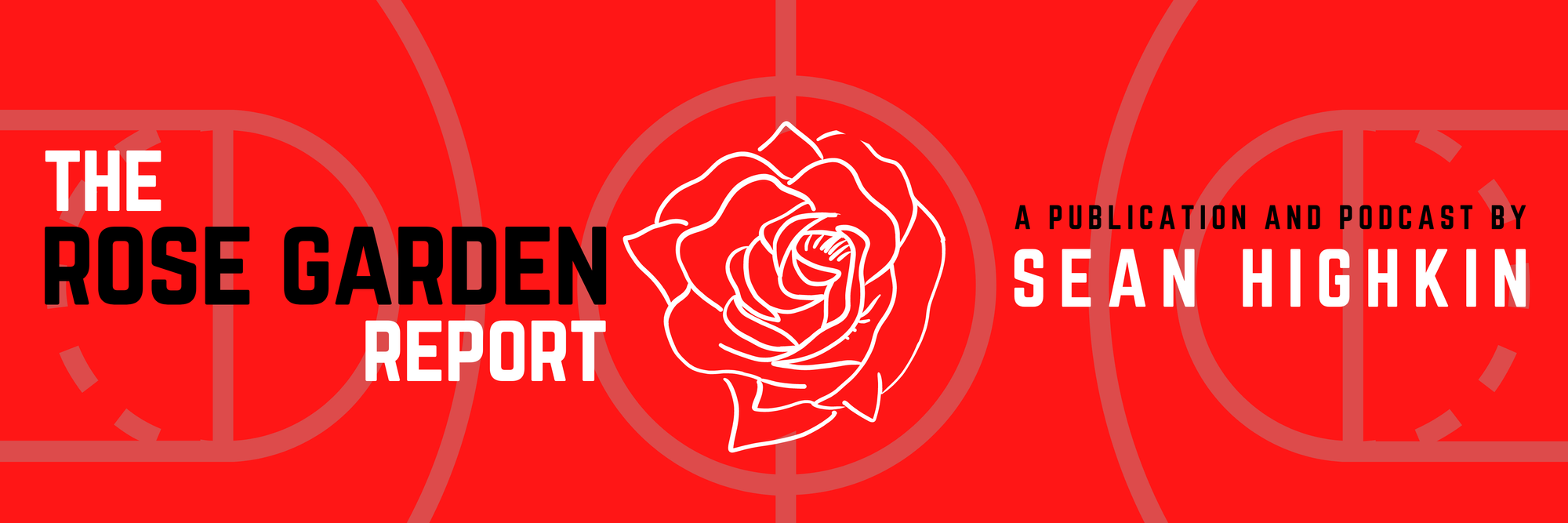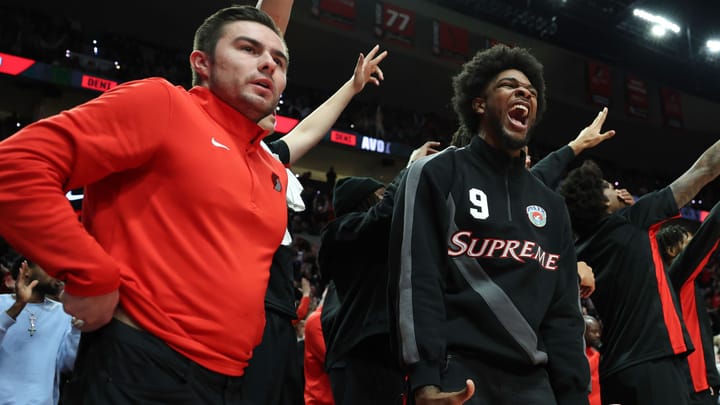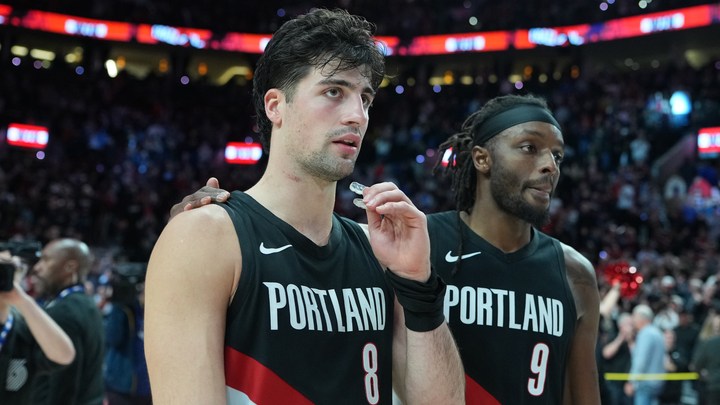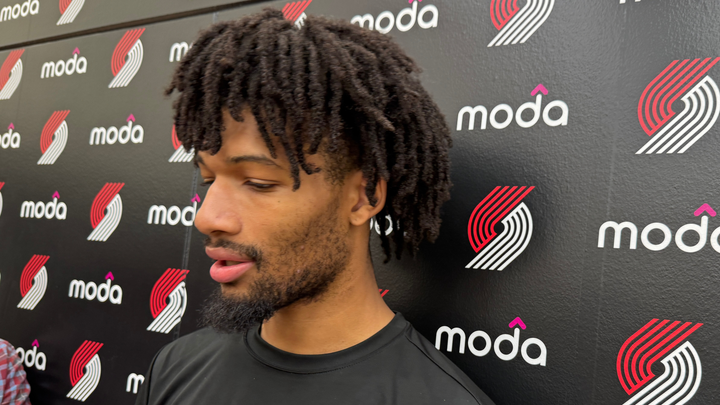What We Know and Don't Know After Blazers' First Two Weeks
Thoughts on the good and bad of the beginning of the year.

Two weeks into the 2023-24 NBA season, there's been a lot that's gone as expected for the Trail Blazers and a lot that hasn't.
I wrote before the start of the season that, entering a rebuild, this year (and probably next) would be about tracking individual player improvement and not wins and losses, but even their record hasn't been as bad as most expected. Portland has been outclassed by the two contenders they've faced, the Clippers and Sixers, but they've hung with everybody else. I still expect their record at the end of the season to be among the worst in the league, but Chauncey Billups has to like what he's seeing when it comes to the effort, togetherness and developing identity he's preached since he took the job in 2021.
"These guys, I'm having so much fun coaching them," Billups said after practice on Monday, the morning after a dispiriting collapse against the Grizzlies. "I just love it. Every time we say there's an issue or concern … before last night's game, we talked about passing. We're not passing the ball well enough. We're missing drive-and-kick opportunities. Then we go into last night's game and we have our best passing game of the year. They do everything we ask them to do. I've been so happy with our team and with our intention and our focus. It's been so much fun."
There's only so much that can be learned definitively from a sample this small. But two weeks in, it's worth attempting to sort out what we know and what we don't.
What we know: Shaedon Sharpe is making the leap
Sharpe moved into the starting lineup in the second game of the season, after Anfernee Simons suffered a thumb injury in the opening-night loss to the Clippers. It was a surprising move at first—if Billups was committed to starting Scoot Henderson and throwing him into the fire, it made more sense on paper to keep the training wheels on a little bit and start Malcolm Brogdon alongside him.
It didn't take long before the world saw why Sharpe had to start. Without a doubt, his play has been the biggest positive of the Blazers' first seven games. Not only was what he did over the final month of last season, when the organizational tank job gave him greater runway to be featured, not a fluke—it was only a taste of what he's capable of.
Sharpe's workload is increasing (his usage has gone up from 19 percent last season to 21.5 percent this season, and he's playing a league-leading 39 minutes per game), and his efficiency is still good. He's getting to the foul line nearly twice as much as he did last season, and his playmaking has improved. Defensively, he still has some things to put together, but his instincts and activity are much improved from where they were as a rookie. He's rebounding at a higher clip than he did a year ago.
Sharpe almost singlehandedly won the Blazers their In-Season Tournament opener against the Grizzlies on Friday, hitting two free throws to tie it, blocking Luke Kennard's corner three attempt at the buzzer to send the game to overtime and hitting a three in the extra period to put Portland ahead. It was his second-half scoring explosion that led the Blazers back from down 18 points to win in Detroit. You can see Billups trust him more game by game.
Long-term, Henderson may still be the face of the franchise. But there's a reason many around the league feel Sharpe actually has the higher ceiling of the two. The jump he's already making has been awesome to watch.
What we don't know: How long Scoot Henderson's learning curve will be
Before the ankle injury in Detroit, Henderson played an encouraging game-and-a-half against the Raptors and Pistons that saw him look much more comfortable than he did in a rough first three games of his NBA career. Now, he'll have to restart that acclimation process whenever he returns to the court. (He's ruled out for tonight's game in Sacramento, but I'd guess he won't be out much longer than that. The Blazers' next game isn't until Sunday, and he's moved and jumped pretty well from what little I've been able to see in practice, so I wouldn't be shocked if he returns before the end of the current road trip.)
It was always going to take a while for Henderson, because it's never overnight for teenage point guards, even the great ones. His debut against the Clippers couldn't have gone much worse than it did. In subsequent games, you saw a few passes not very many people his age can make, but he has yet to have the kind of breakout game that truly announces his arrival.
It will be interesting to see how Billups handles the starting lineup when Henderson is ready to play again. An educated guess is that he'll reinsert him into the starting lineup alongside Sharpe, but I wonder if it wouldn't be better to bring him off the bench, at least for a little bit. Developing him into the star they think he can be is going to be a multi-year project.
What we know: Toumani Camara is a guy
I have to give credit to friend of the program Erik Gundersen for being the first to track one of my favorite stats of the year: total minutes played for Toumani Camara vs. total minutes played for the rest of the second round of the 2023 draft, combined. As of this writing, the tally is 172 minutes over seven games for Camara and 203 combined minutes for the other 15 second-round picks who have seen the court since the season started. Of that group, only two have played more than 30 minutes: Charlotte's Colby Jones (50) and Golden State's Trayce Jackson-Davis (37).
Blazers coaches and front-office staffers have been raving about Camara, both publicly and privately, since training camp started, and it's not hard to see why he's earned Billups' trust to play real minutes from opening night on. His box-score stats don't jump off the page, but he does positive things every time he's on the floor. He's fourth on the team in rebound rate and is in four of the five Blazers five-man lineups that have played at least 10 minutes this season with a positive net rating (points scored vs. allowed per 100 possessions).
Camara had been on the Blazers' radar for a while. They brought him in for a workout during the predraft process and liked him, but ultimately took Rayan Rupert instead with the No. 43 overall pick. Camara popped at Summer League with the Suns after being taken 52nd overall, and the Blazers asked for him along with Deandre Ayton from the Suns as multi-team Damian Lillard trade talks heated up. Nationally, Ayton was the most-discussed part of that deal from Phoenix's end, but Camara wasn't just a throw-in to make the salary work. The Blazers actively wanted and pursued him because he fit the mold of mature, defensive-minded prospects this front office likes, similar to Jabari Walker in last year's draft.
Every year, there are one or two second-rounders that immediately make a real impact as rookies. Last year, that guy was Andrew Nembhard in Indiana. The year before, it was Herb Jones Jr. in New Orleans. This year, it's Camara. The Blazers have already figured out that they can't keep him off the floor. It's only a matter of time before they have to find a way to start him.
What we don't know: Where Deandre Ayton falls on the offensive hierarchy
Things went sideways for Ayton in Phoenix for a lot of reasons—personality clashes with Monty Williams and Chris Paul and his displeasure at not getting a contract extension among them—but part of it was the former No. 1 overall pick taking a backseat to Kevin Durant, Devin Booker and Paul when it came to who got shots. Going to a rebuilding Blazers team without clear offensive hierarchy post-Lillard would seem to mean Ayton would be clear to put up monster numbers.
Thus far, it hasn't gone that way. In fact, Ayton is featured less than ever. His usage rate of 15 percent is easily the lowest mark of his career, as are his 8.9 field-goal attempts per game. He's leading the league in rebounding—both total boards per game at 13.3 and rebounding rate at 23.3 percent—and has had some good defensive performances, but the offense hasn't been what anyone thought it would be.
Part of that might be both Henderson and Simons being out, leaving only Brogdon as a reliable facilitator to feed a center like Ayton, who isn't a shot creator.
The Blazers' early backcourt injuries have forced more players than just Ayton to play outside their regular roles. Jerami Grant has been encouraged to create for himself more, and Brogdon has been handed more playmaking responsibility. Everyone's adjusting, and the results have been as mixed as you'd expect. In a perfect world, Ayton would be somewhere in range between Simons and Grant on the hierarchy of shot attempts. So far, he's still finding his way to be featured more.
What we know: Malcolm Brogdon is too valuable to trade…for now
I don't know as it stands in early November whether the Blazers will move Brogdon before the Feb. 8 trade deadline, as most people assumed they would when he came over from Boston in the Jrue Holiday deal a day before camp started. But I do know that it would be difficult to replace what he's brought thus far, both on the court and in the locker room.
With Simons' injury and Henderson's inconsistent early play, Brogdon has been invaluable as a stabilizer and organizer. And at least so far, he's been totally bought-in to what Billups has asked of him as far as mentoring Henderson and Sharpe. As they start a rebuild, the organization knows the importance of having at least a couple of veterans in the locker room with all the kids. You saw how much of a disaster the last two years were in Houston without that element. And in the short term, Brogdon has filled that role perfectly.
Could their stance change before the deadline? Sure. But right now, it's not something they're thinking about.
What we don't know: How they'll fill the hole left by Robert Williams III's injury
As disappointing as Simons' extended absence following his thumb surgery is, there was a silver lining there in the way it forced Billups to turn Sharpe loose. A similar dynamic does not exist with the loss of Williams, who will have to undergo right knee surgery after an injury he suffered in Sunday's loss to Memphis. There's still no official word on exactly what type of surgery he needs, or how long he'll be out, but it's safe to assume he won't be back anytime in the foreseeable future.
Unlike the Blazers' strong guard depth, there isn't an obvious solution to fill the hole Williams' absence leaves. Jabari Walker has played center in some smaller lineups, which have been successful in limited minutes. With Williams out, Walker will see more time at center, but his natural position is power forward. Does Moses Brown get real minutes? He had a good year with the Clippers last season but hasn't played yet for Portland, even in garbage time. Will two-way big man Duop Reath see some time? The Blazers kept him over Ibou Badji in the third two-way spot because they saw Reath as more ready to play at the NBA level if they needed him to. Now, they might.
The beauty of the Blazers' current situation is that losing Williams doesn't tank their playoff hopes, because that isn't a factor this season. But they got back two high-level, starting-caliber bigs in the Lillard trade, and now one of them is out, possibly for the whole season. That's going to make a lot of people's jobs harder.




Comments ()